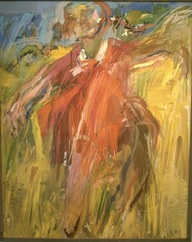Permaculture (PC) is a theme that has threaded its way through our talking and practising during the Workshop for Writers. At the start of our very first session, by the beach in Tejakula, Prapto asks me to talk to the group about PC. I explain that the first design principle is to observe and interact, and how I see the practice of Amerta movement as uniquely helpful in complying with PC teacher Warren Brush's suggestion that PC practitioners must learn to align their movement with nature. Some days later, Prapto contrasts digging (analysis) with tuning (process), later on commenting: "Tuning not adaptation - has sense of creating something". This idea of tuning would be immediately recognisable to PC designers, who will spend as long as it takes to understand the landscape and the needs of its inhabitants before considering any significant changes.
In his introductory comments for a public discussion on body architecture, on the second day of the series of events linked to the book-launch, Prapto describes PC in terms of healthy bodies, healthy environment and healthy economy. One of the discussants, Ibed Surgana Yuga, mentions at one point the body in dialogue with the architecture of nature. I related these comments back to a challenge Prapto previously set me, to think about the place of art in PC. Thinking about the dimension of aesthetics for us as architects of living systems, I wondered whether we should be thinking of PC primarily as a design science, the skilful application of established principles to achieve a desired technical outcome, or more about the skilful placement and combination of elements in the landscape as an act of artistry. To what extent should our design choices be swayed by aesthetic considerations when a healthy, self-sustaining ecosystem is going to be beautiful anyway?
When Prapto reminisced about giving a workshop in Santa Barbara, California in 2011, he said that was when he learnt about PC, and understood that human design could take inspiration from natural systems in ways that would meet human needs without destroying the ecosystems that we ultimately depend on. When we are contemplating changes to our living arrangements, taking the time to move freely in full receptivity to the information in the landscape of our lives and our environment, we can be sensitive to all the needs that need to be met - practical and aesthetic. Amerta and Permaculture - a natural fit.
........................................Posted by Hugh Kelly
In his introductory comments for a public discussion on body architecture, on the second day of the series of events linked to the book-launch, Prapto describes PC in terms of healthy bodies, healthy environment and healthy economy. One of the discussants, Ibed Surgana Yuga, mentions at one point the body in dialogue with the architecture of nature. I related these comments back to a challenge Prapto previously set me, to think about the place of art in PC. Thinking about the dimension of aesthetics for us as architects of living systems, I wondered whether we should be thinking of PC primarily as a design science, the skilful application of established principles to achieve a desired technical outcome, or more about the skilful placement and combination of elements in the landscape as an act of artistry. To what extent should our design choices be swayed by aesthetic considerations when a healthy, self-sustaining ecosystem is going to be beautiful anyway?
When Prapto reminisced about giving a workshop in Santa Barbara, California in 2011, he said that was when he learnt about PC, and understood that human design could take inspiration from natural systems in ways that would meet human needs without destroying the ecosystems that we ultimately depend on. When we are contemplating changes to our living arrangements, taking the time to move freely in full receptivity to the information in the landscape of our lives and our environment, we can be sensitive to all the needs that need to be met - practical and aesthetic. Amerta and Permaculture - a natural fit.
........................................Posted by Hugh Kelly


 RSS Feed
RSS Feed